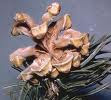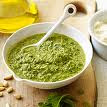Pine nuts are grown on several different types of pine tree, notably on the Stone Pine (Pinus pinea) which is native to the Iberian Peninsula and Italy. It takes along time before a tree can be commercially harvested and the process of extracting the pine nuts, which are really seeds, has to be done by hand. That makes the harvesting of pine nuts labour intensive and so they are expensive. There are pine nuts growing all over the world, and these are called Chilgoza in Pakistan.
Pine trees are the source of turpentine oil used in paints and varnishes and also are used for their resin which may be added to varnishes or used to make rosin for violin bows. The resin is also made into “brewer’s pitch” which used to be used for coating the inside of beer casks, and which can be used for distilling resinous oils. Tar is obtained from the roots of Pinus sylvestris, and this is impure turpentine.
 |
| pine cone |
No doubt hunter-gatherers collected pine nuts and the trees have been cultivated for more than 6000 years. The Roman legions carried them with them to give them energy boosts and for nourishment. In ancient Rome they were a staple food for the ordinary citizens along with wheat or barley porridge, but the wealthier classes used them as aphrodisiacs and stuffed the dormice with them along with herbs, rice and honey. (The little mice were farmed for the purpose of eating and were considered a delicacy.) Galenus wrote in 200 AD that they were a great aphrodisiac and that a man wishing to get back his youthful sexual vigour should take “A glass of thick honey, plus 20 almonds, and 100 pine nuts, repeated for three nights.” As pine nuts contain zinc they will help with erectile problems. They were also mentioned as an aphrodisiac in the 16th century Arab sex manual “The Perfumed Garden” which was translated into English in the 19th century by Sir Richard Burton (not the actor). They were also used to boost the libido in Mediaeval times.
In 1666 Pope Clement IX ordered that a pine nut plantation should be grown on the coast near Rome so that he could be sure of a plentiful supply. Archaeologists excavating Pompeii found stores of pine nuts underneath the volcanic ash. Even today they are much prized in Italian and Greek cuisine. In Greek they are koukounaria and pignoli in Italian.
They contain the minerals calcium, iron, magnesium, phosphorous, potassium, zinc, copper and manganese. The amino acids, and the following vitamins: - Vitamin C (ascorbic acid), the B-complex vitamins,thiamin, riboflavin, niacin, pantothenic acid, B6, folate and B12, along with traces of selenium. They help protect from cardiovascular disease, cancer and the symptoms associated with ageing including delaying the onset of Alzheimer’s and Parkinson’s diseases.
Along with basil and Parmesan cheese they are the main ingredients of Pesto sauce. A traditional Greek and Turkish dish is mussels stuffed with rice, dill and pine nuts.
Ingredients
2 cups fresh basil leaves (packed into cup)
¼ cup grated Parmesan cheese
½ cup olive oil
3 tbsps pine nuts
3 garlic cloves, finely chopped
freshly ground black pepper
Method
Place a third of the basil leaves, Parmesan and pine nuts with a drizzle of olive oil into a blender and blend thoroughly. Repeat until all the ingredients have been blended then put them all together and blend once more.
This can be stored in the fridge for up to a week or frozen for a few months. If you freeze it in ice cube trays you can use it if you just want a meal for one person with pasta.
This has Taste and is a Treat.


very Nice blog.... article is very informative... i love this article.... please share some other information like this... you can also read pine nuts in hindi
ReplyDelete